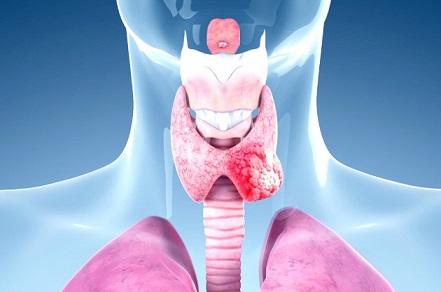Uncovering New Biomarkers in Thyroid Cancer: A Path to Better Diagnosis and Treatment
Nikhil Prasad Fact checked by:Thailand Medical News Team Jun 20, 2024 1 year, 5 months, 2 weeks, 2 days, 7 hours, 55 minutes ago
Cancer News: The Rising Concern of Thyroid Cancer
Thyroid cancer, though accounting for a small percentage of all cancers globally, is on the rise. In Chile, for instance, the incidence has grown significantly, with new cases estimated at 1300 per year. This increase is largely attributed to better diagnostic methods, including advanced imaging techniques and genetic insights. Understanding thyroid cancer and improving its diagnosis and treatment are crucial, especially given its varying forms and aggressiveness. This
Cancer News report covers a study review by researchers from Clinica INDISA, Santiago-Chile, Universidad Andres Bello-Chile and University of Chile which identifies new biomarkers for thyroid cancer.
 Uncovering New Biomarkers in Thyroid Cancer: A Path to Better Diagnosis and Treatment
Understanding Thyroid Cancer
Uncovering New Biomarkers in Thyroid Cancer: A Path to Better Diagnosis and Treatment
Understanding Thyroid Cancer
Thyroid cancer develops in two primary cell types: follicular cells, responsible for iodine uptake and hormone production, and parafollicular cells, associated with calcitonin production. Thyroid cancers are typically classified into three main categories based on differentiation levels: low-grade (including papillary and follicular carcinomas), high-grade (poorly differentiated carcinomas), and anaplastic thyroid cancer (the most aggressive form). Papillary thyroid carcinoma (PTC) is the most common and has several subtypes with varying clinical behaviors.
Traditional Diagnostic Methods
Traditionally, diagnosing thyroid cancer involves imaging techniques like ultrasound and fine-needle aspiration cytology (FNAC). The Bethesda System classifies FNAC results into six categories, from non-diagnostic to malignant. However, these methods often fall short in providing conclusive pre-surgical recommendations, especially for indeterminate cases.
The Role of Molecular Markers
To address these gaps, molecular markers are increasingly being used alongside traditional methods. These markers include genetic mutations and gene expression profiles, which help in diagnosing and assessing the aggressiveness of thyroid cancers. Despite the availability of commercial molecular tests like Afirma, Thyroseq, and Thyroid Print, their widespread use is limited by cost and variability in results.
Emerging Molecular Markers: The Promise of Non-Coding RNAs
Researchers are exploring new molecular markers to improve diagnosis and prognosis in thyroid cancer. Among these, non-coding RNAs (ncRNAs), particularly microRNAs (miRNAs) and long non-coding RNAs (lncRNAs), show great promise.
MicroRNAs (miRNAs)
miRNAs are small non-coding RNAs that regulate gene expression by binding to target mRNAs. In thyroid cancer, specific miRNA profiles can help stratify tumors. Commercial tests like ThyraMIR and mir-THYpe analyze changes in miRNA expression to predict malignancy. For instance, ThyraMIR examines 11 miRNAs linked to cancer, while mir-THYpe uses a panel of miRNAs to differentiate between benign and malignant tumors.
Long Non-Coding RNAs (lncRNAs)
lncRNAs, longer than 200 nucleotides, regulate gene expression through various mechanisms. Alterations in lncRNA expression are associated with several cancers, including thyroid cancer. Key lncRNAs like HOTAIR, MALAT1, and PTCSC3 have shown potential as biomarkers. HOTAIR, for example, is upregulated in papillary thyroid cancer, promoting tumor growth and invasion.
Mitochondrial Signatures: A New Frontier
Beyond nuclear markers, mitochondrial DNA (mtDNA) and related processes offer new diagnostic opportunities. Mitochondria, the cell's energy powerhouses, play crucial roles in cancer metabolism. Alterations in mtDNA, such as copy number changes and mutations, are linked to various cancers, including thyroid cancer. Additionally, circulating cell-free mtDNA (ccf-mtDNA) in the blood could serve as a non-invasive biomarker for cancer diagnosis and prognosis.
Mitophagy and Cancer
Mitophagy, the process of recycling damaged mitochondria, is vital for cellular health and is implicated in cancer development. Dysregulation of mitophagy-related genes, such as BNIP3 and NIX, can influence cancer progression. Understanding these processes and their genetic markers can enhance our ability to diagnose and treat thyroid cancer effectively.
Conclusion: Towards Better Diagnosis and Treatment
The integration of molecular markers, including non-coding RNAs and mitochondrial signatures, into clinical practice holds the promise of improving thyroid cancer diagnosis and treatment. These biomarkers can complement existing methods, offering more accurate assessments of cancer aggressiveness and aiding in personalized treatment plans. As research progresses, these novel markers may become standard tools in the fight against thyroid cancer, benefiting patients worldwide.
The study review was published in the peer reviewed International Journal of Molecular Sciences.
https://www.mdpi.com/1422-0067/25/12/6719
For the latest
Cancer News, keep on logging to Thailand Medical News.
Read Also:
https://www.thailandmedical.news/news/viral-infections-including-covid-19-and-thyroid-cancer-a-new-threat-emerges
https://www.thailandmedical.news/news/warning-covid-19-mrna-vaccines-can-cause-subacute-thyroiditis
https://www.thailandmedical.news/news/breaking-news-french-physicians-uncover-malignant-pseudothyroiditis,-a-new-type-of-thyroid-cancer-in-a-post-covid-individual
